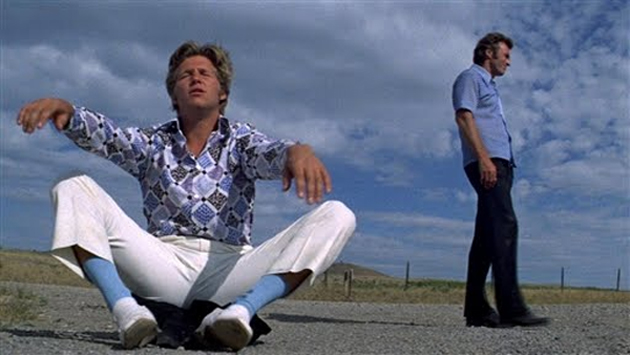THE EIGER SANCTION (1975)

“You think it’s so awful the other side has a germ formula? It’s against the Geneva Convention, isn’t it, and they stole it from us. Well what the hell are we doing with it in the first place?” – Dr. Jonathan Hemlock
As a director, Clint Eastwood’s first three films showed remarkable diversity. Play Misty for Me was a tight and focused domestic thriller; High Plains Drifter was a gritty and haunted western; and Breezy was an understated and intimate romance.
The Eiger Sanction was unlike anything he’d helmed before and was unquestionably his most ambitious work yet as a director. It is part spy thriller, part adventure story, part murder mystery, and features some of the most challenging (and dangerous) location shooting in which Eastwood had yet been involved (in front of or behind the camera). The overall effect is exciting and entertaining, but the ambition does undermine the coherence in places.
Eastwood plays Dr. Jonathan Hemlock, a former assassin who currently holds a job as an art professor who has amassed a small fortune in confiscated paintings. Coerced by his former employer into completing a final job (called a “sanction”), he learns that to seek revenge for the death of a former colleague, he must train and prepare to join a mountain climbing exhibition in which one of his teammates is also an assassin. Not only is the assassin’s identity a secret, but the mountain he will be forced to climb is one Hemlock had tried and failed to climb twice before. Motivated by revenge for his friend and the prospect of life-long freedom from the assassination profession, Hemlock agrees to train for and complete the “Eiger Sanction.”
To a lesser degree than his previous film, Thunderbolt and Lightfoot (which Eastwood did not direct), The Eiger Sanction also has an episodic quality. The film could almost be broken into three very distinct acts which have their own internal climaxes and conclusions. The first act (featuring a brief assassination by Hemlock) is a relatively interesting subplot with good introductions to the major players of the film’s narrative. The third act, wherein the actual “Eiger Sanction” of the title takes place, is easily the most suspenseful and thrilling section of the film. It is the middle section, wherein Hemlock is training for his climb up the Eiger cliffs while simultaneously evading the threat of an eccentric opponent, that threatens to wear out the film’s welcome.
Eastwood had grown disdainful of extensive rewrites to scripts and it’s easy to recognize that the script for The Eiger Sanction could have used some tightening. The middle act certainly has merit, there are decent character moments for Eastwood and for George Kennedy (who Eastwood had befriended on the set of Thunderbolt and Lightfoot and specifically sought out for this film). But it is far too extended given our awareness that the actual Eiger climb is still pending and occasionally offensive in its treatment of the character of Miles Mellough (played by Jack Cassidy) as a caricatured homosexual spy. There are even a few cringe-worthy lines in Hemlock’s seduction of a romantic interest that would likely cause significant controversy today.
Eastwood’s performance is solid as always, but also not tremendously impressive. There’s something to be said for those performers who are so skilled at their craft and so natural within their niche that if they are always “good,” they are perhaps rarely “great,” and this appears to be the case with a lot of Eastwood’s early film work. He is so dependable as a performer that he rarely seems stretched within the narrative and does not explore character possibilities very often.
The scenes on the Eiger climb, however, are breathtaking. This section makes up a mere thirty minutes of the 2 hour plus runtime, but it is a rather intense thirty minutes (I’m actively resisting using the punny word “gripping”). Eastwood performed all his own stunts without the aid of trick photography or special effects, which makes the sequences all the more nerve-wracking. One tragic element, however, is that a crewman died during one of the excavations following a sudden rock slide. Eastwood is on record as having considered cancelling the production entirely out of respect for the crewmember but claims to have been encouraged to complete the film in his memory. The resulting footage is spectacular and one can imagine how jaw-dropping it must have been on the big screen.
Despite the head-scratching plot conveniences (of which there are several) and the patience-testing middle act, The Eiger Sanction still represents an assured and noteworthy achievement for Eastwood and an entertaining film overall. To tackle such an ambitious project with only three directorial credits behind him must have seemed intimidating. But then again, this is Clint Eastwood we’re discussing, so… perhaps not.
 Reed Lackey is based in Los Angeles, where he writes and podcasts about film and faith. His primary work is featured on the More Than One Lesson website and podcast, as well as his primary podcast, The Fear of God (which examines the intersection between Christianity and the horror genre). Follow him on Twitter or on Facebook to receive updates on his reviews and editorials.
Reed Lackey is based in Los Angeles, where he writes and podcasts about film and faith. His primary work is featured on the More Than One Lesson website and podcast, as well as his primary podcast, The Fear of God (which examines the intersection between Christianity and the horror genre). Follow him on Twitter or on Facebook to receive updates on his reviews and editorials.


